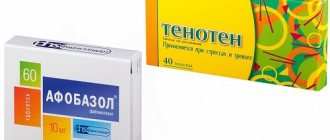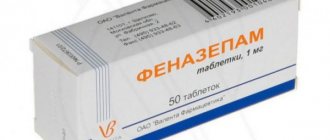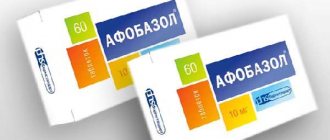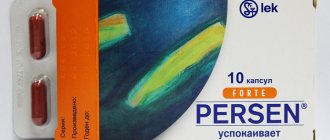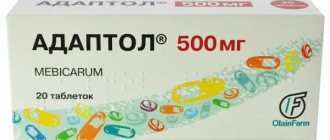The active ingredient is bromodihydrochlorophenylbenzodiazepine . Available in the form of tablets and ampoules with injection solution. Belongs to the group of tranquilizers.
Phenazepam is a psychotropic drug that can reduce fear, panic attacks, anxiety and emotional stress. Has the following effects:
- Anxiolytic.
- Sedative.
- Sleeping pills.
- Muscle relaxant.
- Anticonvulsant.
- Amnestic.
The drug has a calming effect on the central nervous system , thereby reducing signs of depression and panic attacks.
Well absorbed from the gastrointestinal tract. The maximum concentration is observed 1-2 hours after administration . The half-life is 6-18 hours , depending on the characteristics of the human body.
The drug is prescribed for:
- Neuroses.
- Psychosis.
- Sleep disorders.
- Hypochondriacal syndrome.
- Epilepsy.
- Panic attacks.
- Increasing muscle tone.
- Unstable mental state.
- Withdrawal syndrome.
There is also information that the drug is approved for use in preparation for surgical interventions.
Contraindications are:
- Shock and coma.
- Myasthenia.
- Closed glaucoma.
- COPD
- Respiratory failure.
- Pregnancy and lactation period.
- Children under 18 years of age.
- Individual intolerance to the drug.
Patients with liver and kidney failure should take the drug under strict medical supervision.
What is Afobazol
Afobazole belongs to a group of tranquilizers that are used in the treatment of anxiety, fear and restlessness. It has a mild cumulative effect and is not addictive.
The main active substance of this drug is fabomotizole. A distinctive feature and undeniable advantage of Afobazole in comparison with other analogues is that it does not have a relaxing or inhibitory effect. This drug, on the contrary, stimulates the nervous system and increases the speed of thought processes.
At the same time, judging by numerous reviews, Afobazol reduces irritability and nervousness, and also helps normalize sleep. Thanks to its “tenotic” properties, it gradually returns composure and improves the quality of life.
If we compare Afobazol with Phenazepam, then it is the first that helps suspicious, vulnerable and insecure people, as well as people who quit smoking. Indications for its use are conditions such as:
- neurasthenic disorders;
- adaptation disorders;
- anxiety states;
- psycho-emotional overload;
- premenstrual syndrome.
It is often included in treatment regimens for vegetative and somatic diseases. The dosage of Afobazole in each case is selected individually and on average ranges from 5 to 10 mg at a time. If the medicine is well tolerated, the doctor may increase the therapeutic dose. In this case, there is no point in taking Afobazol and Phenazepam together, since the necessary therapeutic effect occurs first after a course of treatment.
Afobazole should be taken three times a day, each time after meals. The positive effect of the drug begins to appear after 5-7 days of use, and the full result is achieved after four weeks of use. The average course of treatment with Afobazole is 4-8 weeks. In case of an overdose of the drug, headaches, nausea and allergic rashes may occur, which go away on their own.
Question from Gulnaz
Hello. My husband regularly goes on a drinking binge. In order for the husband to be able to go to work, the narcologist advised the following: give the husband a drink for 2-3 days, then block further binge drinking with the drugs Phenazepam 5 mg and Haloperidol 5 drops (there was no haloperidol and I gave Sonapax 25 mg 1 tablet). The husband falls asleep and sleeps peacefully all night, and by morning he is able to go to work.
Then for the next 3 days - Mexidol 125 mg/2 times a day, nootropil 480 mg, Teturam (2 t in the morning, 2 in the evening) and 1 amp at night. phenazepam IM. In the future, he advised me to take glycine, neuromultivitis and novopassit, excluding phenazepam. I am interested in the effectiveness of this treatment method, the safety of regular use of phenazepam, haloperidol and sonapax.
What is Phenazepam
Phenazepam is a potent tranquilizer that has a hypnotic, anticonvulsant and muscle relaxant effect. According to the instructions, it is usually included in treatment regimens for epilepsy, insomnia, severe depression and alcoholism.
This drug has a narcotic effect and, with increasing dosage, can cause drowsiness and euphoria or, conversely, aggression and anger. Due to their more powerful effects, in such cases Phenazepam and Afobazole are incompatible, so they are not prescribed together.
In addition, Phenazepam is addictive and, in case of overdose, can cause serious harm to the body. These may be malfunctions:
- of cardio-vascular system;
- gastrointestinal tract;
- hematopoietic system and other pathological conditions.
The average course of treatment with this drug is about two weeks . Abuse of Phenazepam can lead to convulsive and febrile conditions, difficulty breathing, confusion and even coma with subsequent death. Despite the compatibility of Phenazepam with Afobazole, the first drug often leads to the opposite effect and, when it should help cope with depression, causes panic attacks and anxiety.
In such cases, doctors strongly recommend switching from Phenazepam to Afobazol or Grandaxin.
Phenazepam
The active ingredient is bromodihydrochlorophenylbenzodiazepine . Available in the form of tablets and ampoules with injection solution. Belongs to the group of tranquilizers.
Phenazepam is a psychotropic drug that can reduce fear, panic attacks, anxiety and emotional stress. Has the following effects:
- Anxiolytic.
- Sedative.
- Sleeping pills.
- Muscle relaxant.
- Anticonvulsant.
- Amnestic.
The drug has a calming effect on the central nervous system , thereby reducing signs of depression and panic attacks.
Well absorbed from the gastrointestinal tract. The maximum concentration is observed 1-2 hours after administration . The half-life is 6-18 hours , depending on the characteristics of the human body.
The drug is prescribed for:
- Neuroses.
- Psychosis.
- Sleep disorders.
- Hypochondriacal syndrome.
- Epilepsy.
- Panic attacks.
- Increasing muscle tone.
- Unstable mental state.
- Withdrawal syndrome.
There is also information that the drug is approved for use in preparation for surgical interventions.
Contraindications are:
- Shock and coma.
- Myasthenia.
- Closed glaucoma.
- COPD
- Respiratory failure.
- Pregnancy and lactation period.
- Children under 18 years of age.
- Individual intolerance to the drug.
Patients with liver and kidney failure should take the drug under strict medical supervision.
Why aren't they accepted together?
When answering the question about combining the use of Afobazol and Phenazepam, it should be said that these drugs have different purposes . Phenazepam is most often recommended for older people as a sleeping pill, and, despite its low price, it can only be purchased with a doctor’s prescription.
Afobazole can be purchased at any pharmacy without any medical advice. It costs significantly more than Phenazepam and acts much more mildly. To experience the therapeutic effect of Afobazole, you must complete the full course of treatment and use the drug for at least 30 days.
Therefore, in order to answer the question: “Which is better: Phenazepam or Afobazol?” It is necessary to clearly understand the purpose of taking each of these medications. If you relieve signs of mild depression and stress, then, of course, Afobazole. In the treatment of severe forms of depression, Phenazepam will help, however, in this case, consultation with a doctor is necessary.
Source: pillsman.org
Hello, Anatoly! My name is Ekaterina, I’m 32 years old, I’m from the near Moscow region. For the second year now I have been taking phenazepam no more than one tablet a day. In 2011, I had my first panic attack on the street, then at home. The ECG during the attack showed only sinus tachycardia. My blood pressure always rises to 150 due to nervous tension.
At the ambulance they gave me phenazepam under the tongue, Corvalol and valerian. They said that nerves and hidden emotions . I always keep everything to myself, but I had enough stress. So the vegetation “limped”. My brain remembered my first PA, and off we went. Now I even have a phobia of the blood pressure monitor; when I pump air into it, my pulse is already under 120. That’s why I haven’t measured my blood pressure for six months. But my stable has always been 115 to 75.
I haven't had a panic attack for eight months now. But after them there was an unpleasant feeling in the area of the apex of the heart, like emptiness, or a tugging, or a feeling of some kind of non-existence. This is felt only at rest; if you go for a run, do physical work, it all goes away. I probably already have cardioneurosis.
For six months I drank afobazole, persen, novopassit, tenoten, relaxosan, glycine forte, magnesium B6, Corvalol, valerian, read Kurpatov, read the entire website about VSD. NOTHING HELPED. As soon as I take phenazepam, it seems to me that I am “healthy”. And this discomfort in the left side of the chest of a psychogenic nature, as the psychotherapist told me, I can only relieve with phenazepam. I read your article “Withdrawing Phenazepam” and lasted five days without the medicine. On the fifth day in the morning, my whole body felt unpleasant, as if my blood pressure had dropped and I felt terrible weakness.
And then fear appeared again, my heart began to beat, and blood rushed to my head. I took phenazepam under my tongue, and after an hour everything went away. I probably already have endogenous depression , I’m suffering from cardioneurosis, and at the slightest excitement my pulse quickens.
The psychotherapist advises taking Paxil. I haven’t tried it yet, they say there are all sorts of side effects, but it helps someone, I want to try it. After all, sometimes there was even such fear that I couldn’t go outside with the child. And now I can do everything, but only with phenazepam, and I drink it only because of this incomprehensible feeling in the heart area, this feeling is really bothering me.
But the most interesting thing is when you don’t focus on yourself and there is no feeling of it. I was very fixated on my condition. An incomprehensible fear, now I’m afraid to die, now I’m afraid of my heart, but it’s like a Swiss watch, it works and works, and I’m afraid. Life was divided into two parts, before and after panic disorder. So I’m taking phenazepam, I don’t know what to do? The panic disorder has gone away, but this feeling in the heart area remains, or it really is already depression. Maybe try Paxil? I will be grateful to you for your answer. Best regards, Ekaterina. (If I stop taking phenazepam, I will hardly be able to withstand bodily pain without it).
Answer to the question:
How to relieve tension in the nervous system?
From your story I understand that now the general condition is satisfactory. The panic attack is in the past, only minor discomfort in the heart area remains. But this is observed only under one condition. Constant use of phenazepam is required. But everything suggests that, despite taking a tranquilizer, the nervous system is experiencing overexcitation. Such strange phobias as fear of doctors, people in white coats, the sound of an ambulance siren and fear of a medical examination, even the most harmless one, indicate extreme tension in the nervous system.
There are two ways to relieve tension in the nervous system.
The first is taking psychotropic medications. You can take tranquilizers, such as phenazepam. But you need to take it regularly and constantly. The daily dose is small, the therapeutic effect is fast and there are minimal side effects. Although doctors and the instructions for the drug do not advise taking phenazepam for more than one month, most people with panic disorder are saved in this way. You are also on this list. Antidepressants have a slightly different effect on the human nervous system. A huge number of side effects, especially in the first weeks of treatment, when all the symptoms intensify. And as a result, after treatment, the disease remains with the person.
Therefore, you need to perceive psychotropic medications not as a means of eliminating panic disorder, but as an opportunity to give your nervous system a break for a while. Give her the opportunity to soberly assess her condition and work on eliminating her fears on her own. I have a negative attitude towards antidepressants.
The second way is to work with your own thoughts and attitudes.
Why did you give
an attack of PA after stopping phenazepam on the fifth day? Phenazepam has the property of accumulation in the body. It is on the fifth day that the concentration of the drug in the body decreases below the required therapeutic level, and the body is left without outside support. He remains on his own against his panic disorder. The fear of death begins to take precedence over everything else and everything returns to normal. You just need to accept the idea that a person does not live forever and come to terms with it. It sounds simple, but buried in this statement is an attitude towards the disease and the opportunity to recover. Only by coming to terms with your fear of death can you gradually recover. This is the only right direction. phenozepam under the tongue .
Its action is the same when taken orally and sublingually. And the conversation that you can’t stand it without phenazepam is a little exaggerated in your imagination, in your thoughts. Convince yourself of the opposite and everything will work out for you. Anyone who survives one panic attack is already a hero.
Source: vsd-lechenie.com
SIDE EFFECTS OF TRANQUILIZERS
(ANTI ANXIETY DRUGS).
Development of addiction and formation of drug dependence
Signs: the first sign of addiction to the drug is the desire to increase the dose of the drug used, since the previous amount of the drug ceases to give the desired effect and no longer relieves unpleasant symptoms.
further dependence manifests itself in the inability to “get off” the drug: when trying to discontinue the drug, a “withdrawal syndrome” occurs: anxiety, low mood, irritability, heaviness in the head, insomnia, severe weakness, loss of appetite, trembling hands, palpitations, increased blood pressure. Leg cramps and even grand mal seizures and daytime urinary incontinence may occur.
Drugs that cause addiction and dependence:
Most often: Relanium (Seduxen, Sibazon), lorazepam (Lorafen), alprazolam
Reliably less common: Elenium, clonazepam, tazepam (nozepam)
What to do if you become addicted to the drug? It is very difficult to stop taking a tranquilizer on your own if you have developed an addiction due to the duration of the “withdrawal syndrome” (about three weeks), the gradual increase in symptoms by the end of the first week of abstinence, and the possible development of dangerous complications (epileptic seizures). It is most advisable to reduce the dose of the drug very slowly under the supervision of a doctor who, in addition to observation, will be able to select therapy aimed at accelerating the elimination of the drug from the body and relieving unpleasant and painful symptoms.
Attention! Signs of the formation of drug dependence appear within 1 - 1.5 months after starting to take the above drugs (especially Relanium, Lorafen and Alprazolam). Most often, dependence on tranquilizers occurs during self-medication, so it is strongly NOT recommended to prescribe these drugs to yourself without the participation of a doctor.
Deterioration of memory and attention, impaired coordination of movements, increased effects of alcohol
Signs: These side effects are united by the concept of “behavioral toxicity” of tranquilizers. A person feels less efficient, it is difficult for him to concentrate for a long time, it is difficult for him to think quickly and find answers in a conversation, he may immediately forget the facts that are told to him. There is a feeling of insufficient “inclusion” in the situation. There may be motor clumsiness and lack of coordination of movements.
Drugs that most often cause such symptoms: diazepam, clonazepam, lorazepam, nitrazepam, phenazepam, elenium (Librium), estazolam
Attention! Alcohol intake is prohibited during the treatment period. You should refrain from activities related to operating machinery and vehicles.
Excessive sedation
Signs: drowsiness, lethargy, difficulty waking up in the morning.
Drugs that most often cause these symptoms: flunitrazepam (Rohypnol), nitrazepam (radedorm), clonazepam, phenazepam, lorazepam, diazepam (Relanium, Seduxen)
Muscle relaxation
Signs: general weakness, or weakness in certain muscle groups (for example, in the arms), relaxation in the body, reluctance to move again.
Drugs that most often cause these symptoms: diazepam (Relanium, Seduxen), clonazepam, phenazepam, nitrazepam, lorazepam
Paradoxical reactions
Signs: instead of calming and relieving anxiety, opposite reactions to taking a tranquilizer may occur: increased anxiety, motor restlessness, fussiness, irritability and even aggression. Such reactions are rare and depend on the individual characteristics of the patient’s body.
“Paradoxical” reactions have not yet found definitive confirmation of their connection with the use of certain tranquilizers. However, there is evidence that triazolam, for example, quite often contributes to the appearance of pronounced aggressive behavior. In isolated cases, paradoxical reactions in the form of anxiety and sleep disturbances were noted in patients taking buspirone.
Drugs that do not cause excessive sedation, muscle relaxation and impairment of memory and attention: oxazepam (tazepam, nozepam), grandaxin, stresam, buspirone, atarax, afobazole, mezapam (rudotel), clorazepate.
If you are taking mood stabilizers (mood correctors)
Mood correctors
– drugs that have the ability to influence both pathologically depressed and pathologically elevated mood. The ability to regulate mood is manifested in the elimination of severe affective disorders, and then in the stabilization of mood at a certain average level. Thus, the main indication for prescribing mood stabilizers is the presence of depressive and manic attacks that recur quite often.
Most mood correctors (except lithium) are also anticonvulsants used in the treatment of epilepsy.
In addition, mood stabilizers are successfully used in the treatment of:
- personality disorders accompanied by explosiveness, conflict, irritability, aggression
— depression in patients with alcoholism
- migraine
Normotimics include:
- lithium salts (preparations sedalit, micalit, litosan, contemnol, quilonum retard)
- valproic acid (drugs Depakine, Konvulex, Encorate, Apilepsin, Konvulsofin, Dipromal, Orphyril, Everiden)
- carbamazepine (synonyms: finlepsin, tegretol, actinerval, gene-karpaz, zagretol, zeptol, carbadak, carbalepsin, carbapin, karbasan, carbatol, carzepin-200, mazepin, novo-carbamaz, stazepin, storilat, timonil, finzepin, epial)
SIDE EFFECTS OF NORMOTIMICS.
Side effects of lithium drugs (sedalite, micalite, litosan, etc.)
At the initial stage of preventive therapy with lithium salts, mild side effects may appear in the form of increased fatigue, disorders of the digestive system (nausea, vomiting, diarrhea), and occasional mild hand tremors. At acceptable concentrations of lithium in the blood (within 0.5 - 0.8 mEq/L), these phenomena do not require a dose reduction and usually disappear as the body adapts to the drug.
With a relative duration of treatment (over several months and years), the following may appear:
- diffuse enlargement of the thyroid gland
- noticeable weight gain
- minor swelling
- temporary deterioration in vision clarity.
In these cases, it is sometimes necessary to slightly reduce the dose or switch from using a long-acting (long-acting) drug to taking short-acting drugs in the same dose 2-3 times a day.
The main complication that can occur with long-term use of lithium drugs is intoxication with lithium salts.
Early signs of lithium overdose: increased thirst and trembling fingers. Then lethargy, weakness, and drowsiness appear. Then vomiting and diarrhea occur, swelling increases, speech difficulties and heart rhythm disturbances appear.
At the first signs of intoxication, you must immediately stop taking the drug and consult a psychiatrist, who will prescribe treatment aimed at accelerating the elimination of lithium from the body and relieving symptoms of intoxication.
Provoking factors that increase the concentration of lithium in the blood: a diet with limited salt and liquid, combination with indomethacin, some antibiotics (ampicillin, tetracycline)
Attention! Treatment with lithium preparations is carried out with regular monitoring of the concentration of lithium in the blood plasma:
- in the acute period (treatment aimed at “breaking off” a painful attack): the concentration of lithium in the blood is monitored daily, and it should not exceed 1.2 - 1.4 meq/l
- selection of a daily dose for prophylactic use (treatment is aimed at preventing repeated attacks of depression or manic states) requires determining the concentration of lithium in the blood, first once a week during the first month, then 1 - 2 times a month, after 7 months of therapy - once at 3 – 4 months. The lithium concentration that provides a preventive effect should be in the range of 0.5 – 0.8 mEq/L
Side effects of valproic acid drugs (convulex, depakine, encorate, etc.)
The most common side effects of valproic acid therapy are gastrointestinal disorders: nausea, diarrhea, loss of appetite.
Possible excessive sedative effect in the form of drowsiness, slowing down of thought processes.
Also possible: tremor (shaking of hands), loss of coordination of movements.
When using long-acting drugs used once a day (for example, Depakine Chrono), side effects occur more often, it is possible that appetite may increase rather than decrease, and hair loss is sometimes observed.
To prevent these phenomena, it is advisable to combine valproic acid with a daily intake of multivitamins with a set of microelements, including, in particular, selenium and zinc.
Side effects of carbamazepine (finlepsin, tegretol)
When carrying out carbamazepine therapy, side effects are expressed in headaches, dizziness, loss of coordination of movements, drowsiness, dermatitis or skin itching, sometimes double vision, blurred vision.
As with other mood stabilizers, side effects such as nausea and vomiting are possible.
However, in most cases, carbamazepine is well tolerated, even with long-term use.
If you take nootropics (meals that improve nutrition and brain function)
Nootropics
– medications that stimulate mental activity, improve memory, and accelerate learning processes.
Application: decreased general activity, asthenic conditions of various origins, brain lesions (vascular, traumatic, alcoholic, infectious), conditions after strokes, coma, dementia, in pediatric practice: with intellectual disability, developmental delay, attention deficit hyperactivity disorder (ADHD) ), tics, enuresis.
Noothorps are always used in the treatment of alcoholism.
Effects of nootropics (present in different drugs in different amounts):
— Psychostimulating (increasing the activity of the sphere of impulses) – used in states of decreased activity, inactivity and apathy, intellectual inhibition
— Antiasthenic (reduction of weakness, increased physical and mental exhaustion)
— Increasing the level of wakefulness of consciousness - used in states of depressed or darkened consciousness
— Adaptogenic – increasing the resistance of the body and psyche to various harmful environmental factors, including intoxications
— Nootropic (strengthening the functions of thinking, memory)
— Antiepileptic (for some drugs)
— Antiparkinsonian (used not only for Parkinson’s disease, but also to relieve the unpleasant side effects of antipsychotic therapy - see above)
— Vegetotropic (stabilization of the autonomic nervous system)
Table of synonyms for nootropic drugs.
| International name of the drug | Names of this drug that are found in pharmacies (the most commonly found dosage forms in pharmacy chains are highlighted) |
| Drugs with a predominant stimulating, activating effect (cannot be taken at night as it may impair sleep) | |
| Meclofenoxate | Acefen, Centrophenoxine, Cerutil |
| Phenylpiracetam | Fenotropil |
| Ethylthiobenzimidazole | Bemitil |
| Pyritinol | Encephabol, Pyriditol, Cerebol, Enerball |
| Piracetam | Nootropil, Piracetam, Lucetam, Memotropil, Oykamid, Cerebril, Stamin, Escotropil, Piratropil |
| Piracetam + cinnarizine | Fezam, Combitropil, NooKam, Omaron, Piracezin |
| Piracetam + Vinpocetine | Vinpotropil |
| Deanol aceglumate | Demanol, Noocleril |
| Gamma-aminobutyric acid | Aminalon |
| Glutamic acid | L-Glutamine, Calcium glutamate, Epilapton, Acidogen, Glutan |
| Hexobendine+Etamivan+Etophylline | Instenon |
| Ginkgo biloba | Tanakan, Bilobil, Gikoba, Ginkyo, Memoplant |
| Preparations with balanced action | |
| Methionyl-glutamyl-histidyl-phenylalanyl-prolyl-glycyl-proline | Semax |
| Cerebrolysin | Cerebrolysin |
| Choline alphoscerate | Gliatilin |
| Drugs with a predominant sedative, calming effect | |
| Ethylmethylhydroxypyridine succinate | Mexidol |
| Aminophenylbutyric acid | Phenibut |
| Nicotinoyl gamma-aminobutyric acid | Picamilon |
| Hopantenic acid | Pantogam |
| Sodium hydroxybutyrate | Sodium hydroxybutyrate |
| Glycine | Glycine |
SIDE EFFECTS OF NOOTROPICS
Nootropics are low-toxic drugs and are usually well tolerated by patients.
Side effects may include sleep disturbances and increased irritability. Such effects are inherent in nootropics with a predominant stimulating effect. These include (in descending order of stimulating effect): acephen, phenotropil, bemitil, encephabol, nootropil (piracetam), demanol, aminalon.
On the contrary, drugs with a predominance of a mild sedative (calming) effect do not cause increased irritability, anxiety and sleep disturbances, and even relieve these unpleasant symptoms. Nootropics with a predominant calming effect include phenibut, mexidol, picamilon, pantogam.
Other side effects of nootropics (occur quite rarely, are unstable and pass quickly): headache, nausea, stool disorders, fluctuations in blood pressure
Source: www.granatmc.ru
More
If you do not have generalized anxiety disorder and panic attacks, your anxiety arises only in stressful situations (exam, performance, important event), it is still better to visit a good psychiatrist or psychotherapist and discuss the correction option with him.
Sometimes the problem turns out to be deeper than originally thought. Medications can include tranquilizers and beta blockers. The use of tranquilizers is limited by side effects, and beta blockers have a weak evidence base.
If valerian and similar drugs help you, you can consider them your personal placebo. Often these drugs are effective in particularly suggestible patients. In addition, the alcohol contained in the tincture helps. Do you need alcohol before an exam? So psychotherapy is a good option for solving the problem.
Source: yandex.ru
